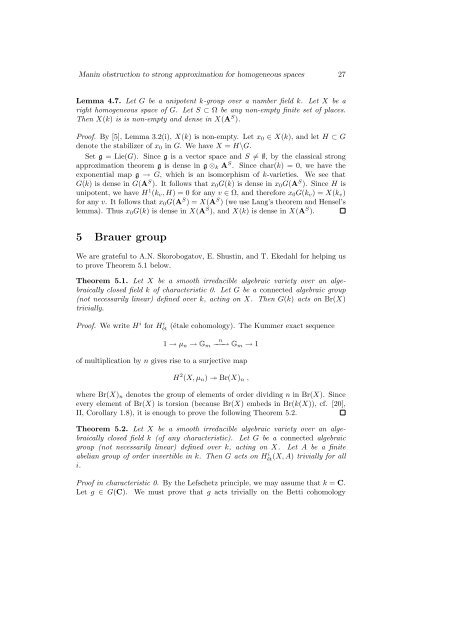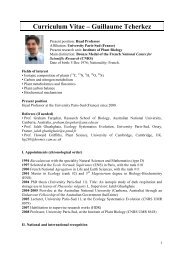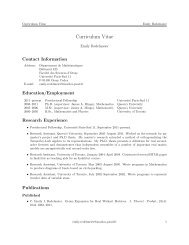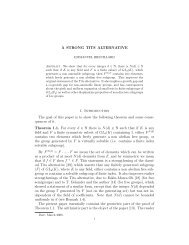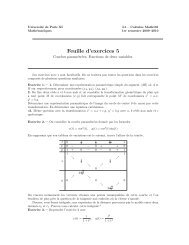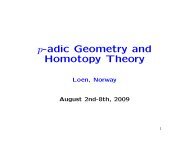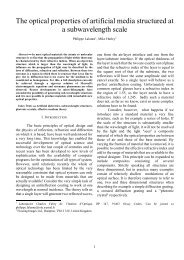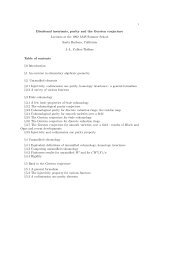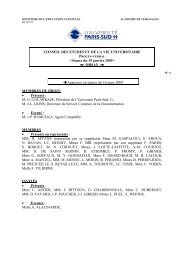Manin obstruction to strong approximation for homogeneous spaces
Manin obstruction to strong approximation for homogeneous spaces
Manin obstruction to strong approximation for homogeneous spaces
You also want an ePaper? Increase the reach of your titles
YUMPU automatically turns print PDFs into web optimized ePapers that Google loves.
<<strong>strong</strong>>Manin</<strong>strong</strong>> <<strong>strong</strong>>obstruction</<strong>strong</strong>> <<strong>strong</strong>>to</<strong>strong</strong>> <strong>strong</strong> <strong>approximation</strong> <strong>for</strong> <strong>homogeneous</strong> <strong>spaces</strong> 27Lemma 4.7. Let G be a unipotent k-group over a number field k. Let X be aright <strong>homogeneous</strong> space of G. Let S ⊂ Ω be any non-empty finite set of places.Then X(k) is is non-empty and dense in X(A S ).Proof. By [5], Lemma 3.2(i), X(k) is non-empty. Let x 0 ∈ X(k), and let H ⊂ Gdenote the stabilizer of x 0 in G. We have X = H\G.Set g = Lie(G). Since g is a vec<<strong>strong</strong>>to</<strong>strong</strong>>r space and S ≠ ∅, by the classical <strong>strong</strong><strong>approximation</strong> theorem g is dense in g ⊗ k A S . Since char(k) = 0, we have theexponential map g → G, which is an isomorphism of k-varieties. We see thatG(k) is dense in G(A S ). It follows that x 0 G(k) is dense in x 0 G(A S ). Since H isunipotent, we have H 1 (k v , H) = 0 <strong>for</strong> any v ∈ Ω, and there<strong>for</strong>e x 0 G(k v ) = X(k v )<strong>for</strong> any v. It follows that x 0 G(A S ) = X(A S ) (we use Lang’s theorem and Hensel’slemma). Thus x 0 G(k) is dense in X(A S ), and X(k) is dense in X(A S ).5 Brauer groupWe are grateful <<strong>strong</strong>>to</<strong>strong</strong>> A.N. Skoroboga<<strong>strong</strong>>to</<strong>strong</strong>>v, E. Shustin, and T. Ekedahl <strong>for</strong> helping us<<strong>strong</strong>>to</<strong>strong</strong>> prove Theorem 5.1 below.Theorem 5.1. Let X be a smooth irreducible algebraic variety over an algebraicallyclosed field k of characteristic 0. Let G be a connected algebraic group(not necessarily linear) defined over k, acting on X. Then G(k) acts on Br(X)trivially.Proof. We write H i <strong>for</strong> Het í (étale cohomology). The Kummer exact sequence1 → µ n → G mn−−→ G m → 1of multiplication by n gives rise <<strong>strong</strong>>to</<strong>strong</strong>> a surjective mapH 2 (X, µ n ) ↠ Br(X) n ,where Br(X) n denotes the group of elements of order dividing n in Br(X). Sinceevery element of Br(X) is <<strong>strong</strong>>to</<strong>strong</strong>>rsion (because Br(X) embeds in Br(k(X)), cf. [20],II, Corollary 1.8), it is enough <<strong>strong</strong>>to</<strong>strong</strong>> prove the following Theorem 5.2.Theorem 5.2. Let X be a smooth irreducible algebraic variety over an algebraicallyclosed field k (of any characteristic). Let G be a connected algebraicgroup (not necessarily linear) defined over k, acting on X. Let A be a finiteabelian group of order invertible in k. Then G acts on Het í (X, A) trivially <strong>for</strong> alli.Proof in characteristic 0. By the Lefschetz principle, we may assume that k = C.Let g ∈ G(C). We must prove that g acts trivially on the Betti cohomology


